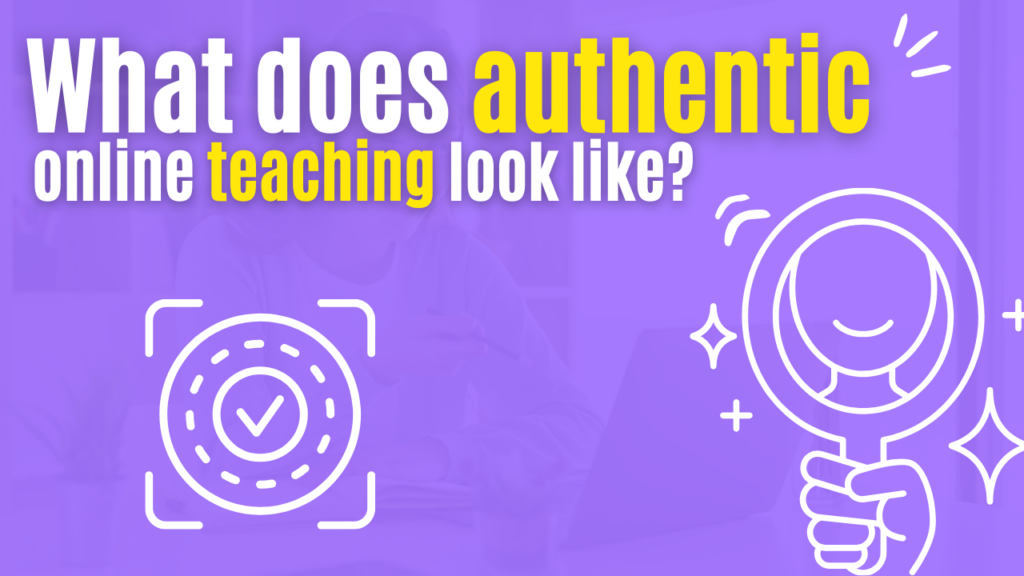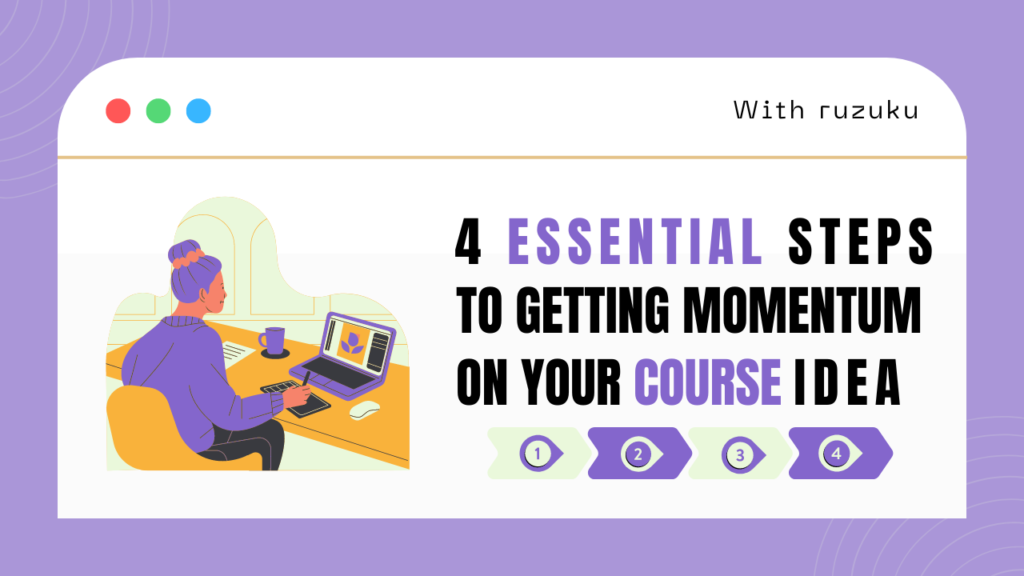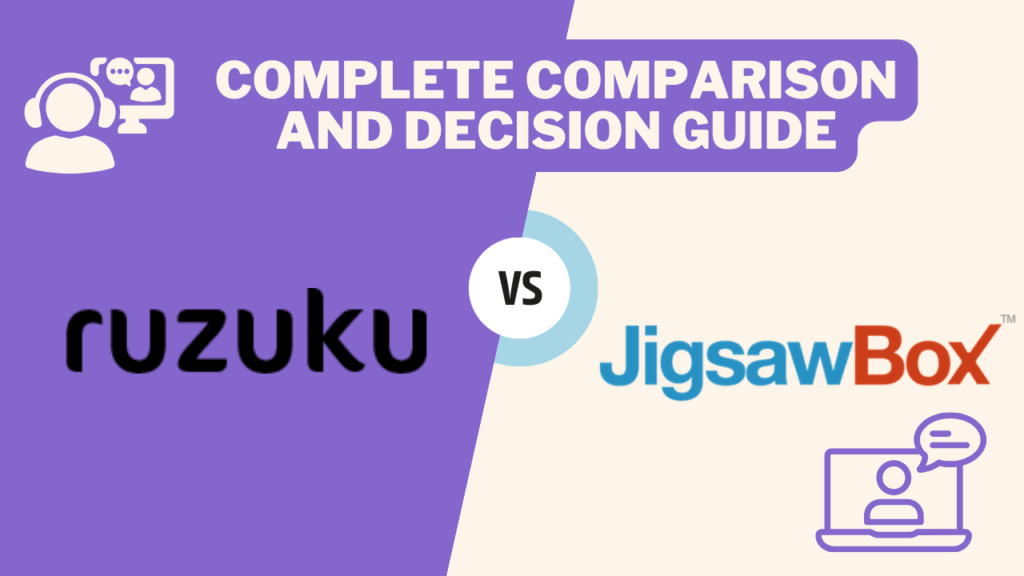Today’s paradox:
We have unleashed opportunities — and technologies — for genuinely transformative online learning.
Inspiring teachers are creating online programs of such power and depth…
Yet at the same time the label “online course” is being slapped on virtually any collection of content… devaluing the very idea of teaching online!
We believe in authentic online teaching that is grounded in personal connection and interaction.
It’s not for everyone.
This vision is at odds with dreams of “scale.”
It might mean serving 10 people deeply — rather than 10,000 in a shallow, surface-only way.
The rewards, though, can be great:
The feeling that you’re truly helping even 1 person learn and develop is incredibly powerful.
How can we achieve this?
How can we bring humanity and connection into our online courses?
We’ve found two approaches. The first is to embrace your unique voice and point-of-view. The second is to be deeply present and personal in your online programs.
1. Embrace your unique voice and point-of-view

Have you ever felt like you’re treading water in an ocean of meaningless “content” and pseudo-education?
I struggle with this a lot.
Information alone doesn’t help. We’re practically drowning in information.
We’re hungry for meaning, insight, and clarity.
We need:
Personal voice that activates human connection and motivation…
“Hey, this person really cares about this topic, so I’m going to pay attention.”
And we crave:
A strong point-of-view that gives us something to hold on to, and focus on.
A clarity that makes us think, “yes, there are a million ways to go about this, but your point of view here really speaks to me, and I’m going to explore it 100% and see where it takes me.”
Diego Rodriguez is a designer at IDEO (one of the leading design/innovation companies in the world).
He writes that having a clear point-of-view is central to creating something that people love:
A person who knew what they wanted and what they did not, what mattered and what did not, a person who was able to listen to everyone but then do what they thought was right. In other words, a person with a point of view.
What is a point of view? Simply put, it is a crisp accounting of what matters which allows one to say no. In the process of trying to bring cool stuff to life, it is so easy to say yes to everything. It’s much harder to say no to the things that don’t matter in the end, and that’s where the art part of the equation plays out. But I can say one thing definitively: if you don’t have a firm point of view about what matters, your chances of doing something remarkable drop to zero. Great things happen when we make choices, and we make good choices when we know what we want.
Above all else, you must have a point of view. Don’t leave home without it.
How can you apply these ideas to your online programs?
To strengthen your personal voice, choose an activity in your course, and try writing it as an email to a trusted friend or family member. Write directly to her.
To develop your point of view, make a list of 10 ideas, topics or activities you have in mind for your course. Next, imagine you have a client who is willing to pay $1 million for your course. But, he only wants the 1 component that matters most — that truly represents your point of view on your topic. Which means you have to cross 9 of those 10 ideas off your list. Now, which one is left? How can you put all of your teaching energy and personal voice into that one idea to make it sing?
And to deepen your understanding of distinct points-of-view, pick 3 blogs that have an especially strong voice and point-of-view, and read them religiously. Here are a few examples of popular blogs with strongs points-of-view: Alexandra Franzen, Tim Ferriss, Delighted. Pay attention to how each person’s voice shines through his/her blog. Reflect on each person’s point of view. What are they saying “no” to? How does this create space for their creativity and expressiveness in other areas?
2. Be present and personal
Your participants feel lost in the “information glut.”
Your mission?
To guide them — with presence, empathy, and care.
Presence is the feeling that a trusted advisor, teacher, coach is by your side, walking with you along your learning path.
That you’re connected and intertwined in a learning experience.
It’s feeling that it’s not just you staring at your computer: you have trusted help.
Powerful, too, is the sense that your teacher has empathy for you as you learn. That she understands some of what you’re feeling as you go through your learning journey.
This empathy may even be grounded in your teacher’s own story and experiences…
Maybe it’s a health coaching program, and she has experienced some of the same health challenges that you have…
Maybe it’s a writing course, and he has struggled with the same writing blocks as you…
You can learn and develop in a relaxed and effective way when you feel that your teacher cares about your progress and checks in with you to see how you’re doing.
When you ask a question, you can count on a helpful response.
When you feel frustrated, you know who to talk to.
And if life gets busy and your activity in the course drops off, you get a short but kind note to touch base and remind you that you’re not alone in your learning.
How can you apply these ideas to your online programs?
Deepen empathy. When you read the contribution of a participant in your program, pause to consider the emotions (stated or unstated) that she is likely feeling. How can you respond to these emotions?
Go beyond text. Create discussion prompts that invite participants to share images, audio, or video. Responding to these rich media contributions can unlock new opportunities for a sense of presence in the course.
Think about your “welcome experience.” How can you welcome people into your program in a personal and evocative way? Here are some examples to spark your creativity:
- Can you offer a 15-minute call to explore each person’s goals and help personalize the program to her needs?
- Can you provide content that opens the learning experience, such as a motivational video, guided meditation, or other “entry point?”
- Is there an assessment or inquiry that would help your participant understand her learning needs and goals?
- Do you have a favorite book that relates to the themes of your program? How about mailing it to your participants as an “advance reading?”
- Or can you get creative and tangible?
- For example, Tea Silvestre welcomes new participants in her online program with a handwritten thank-you note.
- Melissa Dinwiddie sends her small-group program clients a beautifully painted bookmark with their name and a personal message.
Make live calls/webinars part of your program design. Live interactions provide a sense of presence and personal touch that structured content simply can’t replicate. Create opportunities for people to hear your real voice on a call (and perhaps see you on video, also). This experience builds trust and rapport. Moreover, it establishes a manageable structure: your participants can say, “Hey, I can put this 1 hour call on my calendar each week. That’s something I can commit to, and hold the rest of the world back so I can focus on this learning.”
Your turn…
We’d love to hear your ideas for designing more authentic and personal online courses: shoot us an email, mention us on Twitter (@ruzuku), or if you’re a ruzuku instructor, join our private Facebook group to share ideas with your colleagues.




